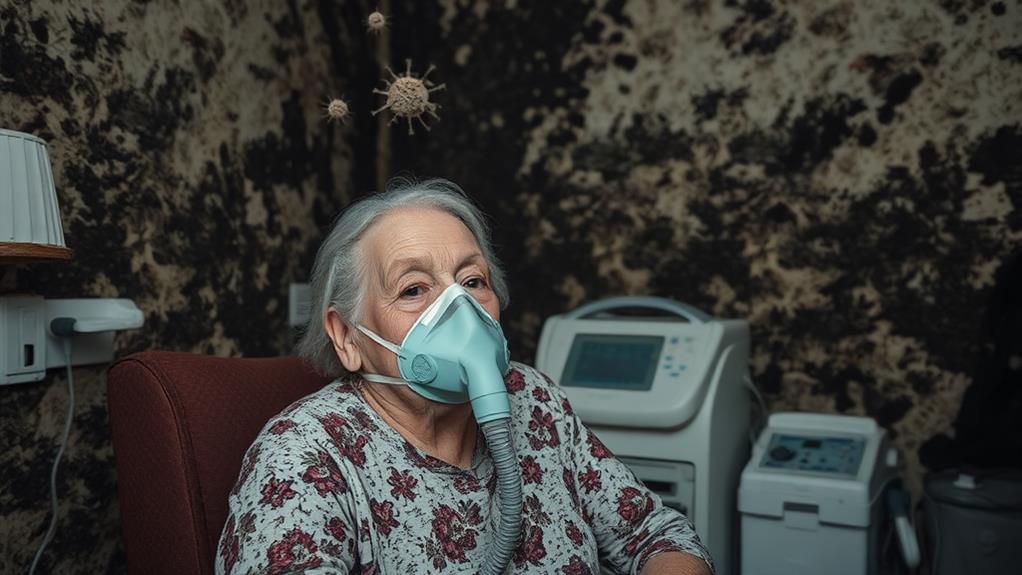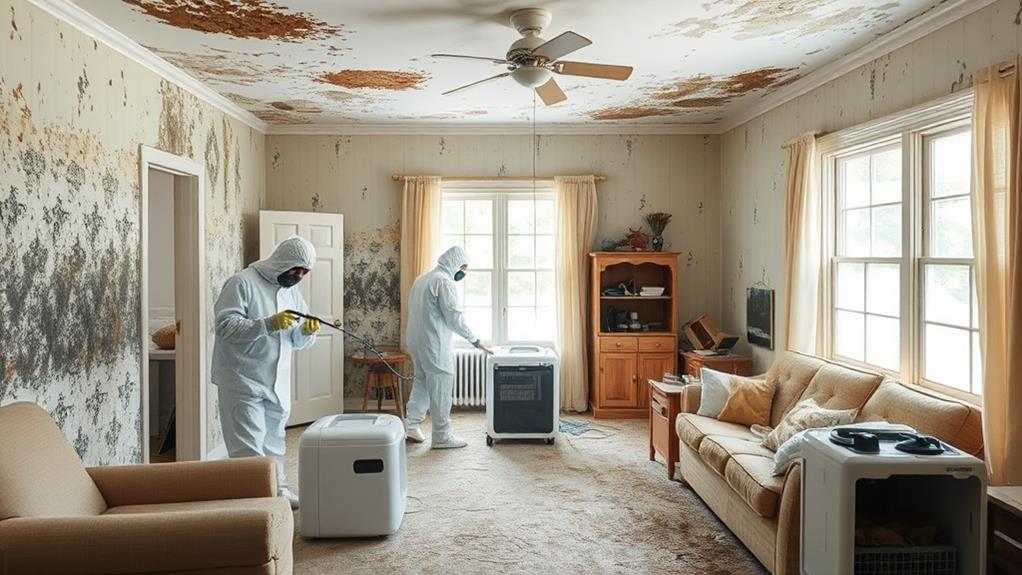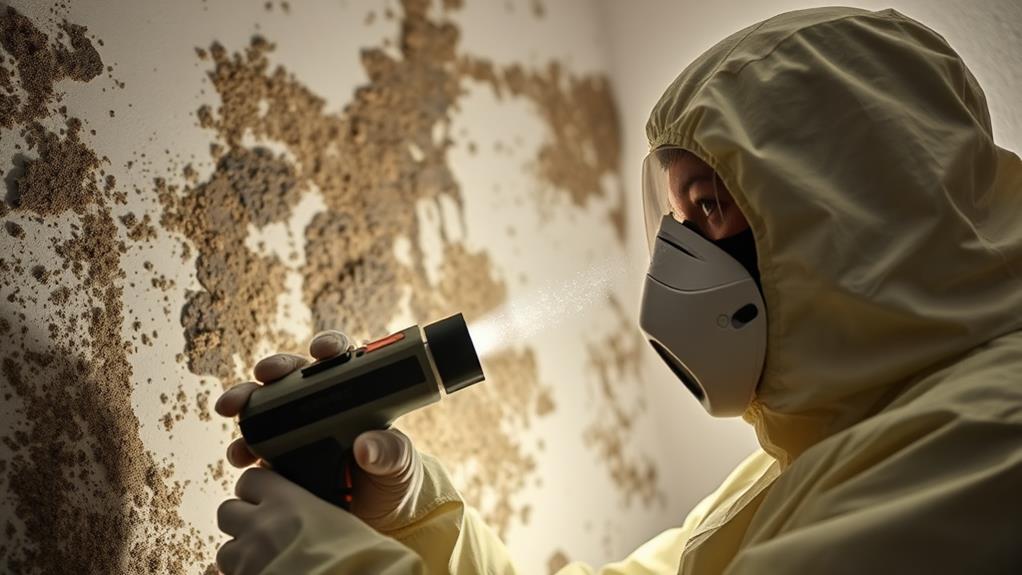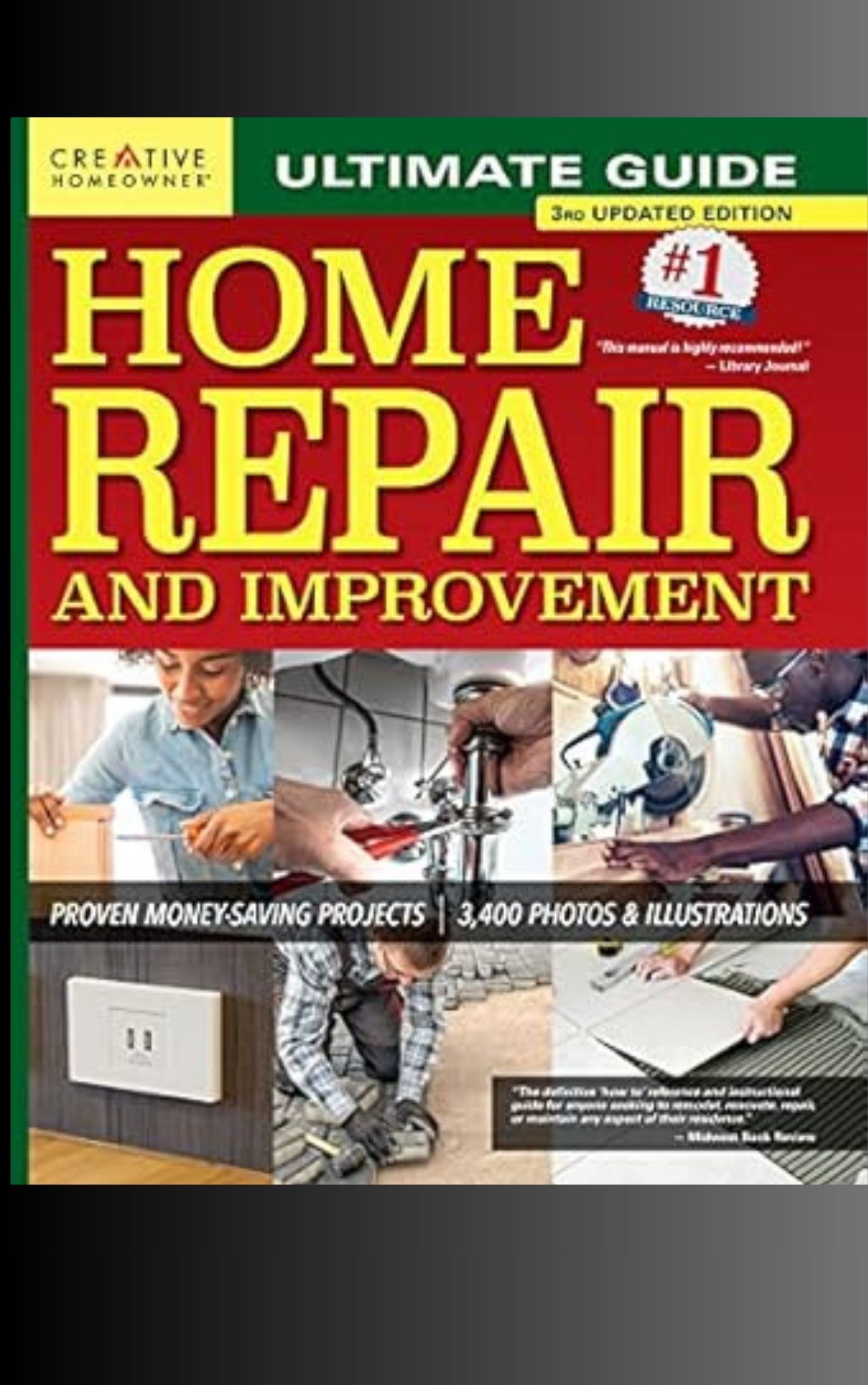Post-flood mold exposure can lead to various health risks. Common symptoms include respiratory issues like coughing and wheezing, nasal congestion, throat and eye irritation, and skin rashes. Mold can trigger allergies and asthma attacks, and may be linked to neurological symptoms. Vulnerable populations, such as infants, elderly, and those with compromised immune systems, face greater risks. Different mold types, including Aspergillus, Penicillium, and Stachybotrys, can produce allergenic spores and mycotoxins. Prompt identification and professional remediation are crucial to mitigate these health hazards. Understanding the full scope of mold-related health risks can help protect you and your family.
Types of Flood-Related Mold

Flood-prone environments create ideal conditions for various mold species to thrive. The most common types of flood-related mold include Aspergillus, Penicillium, Stachybotrys, and Fusarium.
Aspergillus is a widespread genus of mold that can grow rapidly in damp conditions, producing allergenic spores and potentially harmful mycotoxins. Penicillium, another frequent post-flood contaminant, is known for its distinctive blue-green appearance and can cause respiratory issues in sensitive individuals.
Stachybotrys, often referred to as "black mold," is particularly concerning due to its ability to produce potent mycotoxins. This species requires high moisture levels and typically grows on cellulose-rich materials like drywall and wood. Fusarium, commonly found in water-damaged buildings, can produce mycotoxins that may lead to various health problems, including skin infections and allergic reactions.
Other flood-related mold types include Cladosporium, Alternaria, and Chaetomium. These species vary in color, growth patterns, and potential health effects, but all thrive in the moist conditions left behind by flooding. Prompt identification and remediation of these molds are crucial to mitigate health risks associated with post-flood exposure.
Health Effects of Mold Exposure
Exposure to mold can lead to a range of health effects, varying in severity from mild to potentially life-threatening. Common symptoms include respiratory issues such as coughing, wheezing, and shortness of breath. Individuals may also experience nasal congestion, throat irritation, and eye irritation. Skin rashes and headaches are frequently reported among those exposed to mold.
For people with allergies or asthma, mold exposure can trigger more severe reactions, including asthma attacks and allergic rhinitis. Immunocompromised individuals and those with chronic lung diseases are at higher risk of developing fungal infections in their lungs when exposed to certain types of mold.
In some cases, prolonged exposure to toxic molds can lead to more serious health problems. These may include neurological symptoms, memory loss, and mood changes. Some studies suggest a potential link between long-term mold exposure and the development of certain cancers, though more research is needed to establish a definitive connection.
Children, elderly individuals, and those with pre-existing health conditions are particularly vulnerable to the adverse effects of mold exposure. It is crucial to address mold issues promptly to minimize health risks and prevent long-term complications.
Vulnerable Populations

While mold exposure can affect anyone, certain groups face heightened risks and more severe consequences. Infants, young children, and the elderly are particularly vulnerable due to their developing or weakened immune systems.
Individuals with pre-existing respiratory conditions, such as asthma or chronic obstructive pulmonary disease (COPD), may experience exacerbated symptoms when exposed to mold spores.
People with compromised immune systems, including those undergoing chemotherapy, organ transplant recipients, and individuals with HIV/AIDS, are at increased risk of fungal infections and severe reactions to mold exposure. Individuals with allergies or sensitivities to mold may experience more intense symptoms, even with minimal exposure.
Pregnant women should exercise caution, as some studies suggest a potential link between mold exposure and adverse pregnancy outcomes. Occupational exposure is another concern, particularly for workers in flood remediation, construction, and agriculture, who may encounter higher concentrations of mold spores during their daily activities.
Those with a history of mold-related illnesses or hypersensitivity to mold should take extra precautions to avoid exposure in post-flood environments.
Identifying Mold Growth
Recognizing mold growth in post-flood environments is crucial for effective remediation and health protection. Mold can begin to grow within 24-48 hours of water exposure, making early identification essential. Visual inspection is the primary method for detecting mold, which often appears as discoloration on surfaces. Common colors include black, green, brown, or white, and textures may range from fuzzy to slimy.
Mold growth is typically found in damp, dark areas with poor ventilation. Key locations to check include basements, crawl spaces, attics, and behind walls or under carpets. A musty odor is often an indicator of hidden mold growth. To confirm suspected mold, homeowners can use readily available mold testing kits or seek professional assessment.
When identifying mold, it's important to note the extent of growth and the types of materials affected. Porous materials like drywall, insulation, and fabrics are particularly susceptible and may require replacement if extensively contaminated. Non-porous surfaces can often be cleaned and disinfected. Proper documentation of mold growth, including photographs and detailed notes, is crucial for insurance claims and guiding remediation efforts.
Prevention and Remediation Strategies

A comprehensive approach to mold prevention and remediation is essential for mitigating health risks in post-flood environments. Immediate action is crucial to prevent mold growth. Begin by removing standing water and thoroughly drying affected areas within 24-48 hours. Use dehumidifiers, fans, and open windows to improve air circulation and reduce moisture levels.
Clean and disinfect all surfaces with appropriate antimicrobial products. Remove and dispose of porous materials that cannot be adequately cleaned, such as carpets, upholstery, and drywall. For extensive mold growth or contamination in areas larger than 10 square feet, consider hiring professional remediation services.
Preventive measures include maintaining proper ventilation, repairing leaks promptly, and using mold-resistant products in flood-prone areas. Regular inspections and moisture control are vital for long-term prevention. When dealing with mold, always wear personal protective equipment, including gloves, goggles, and respirators.
For effective remediation, identify and address the underlying moisture source. Encapsulate or remove affected materials, depending on the extent of contamination. After remediation, conduct thorough cleaning and air quality testing to ensure the environment is safe for occupancy.
Long-Term Health Consequences
Prolonged exposure to mold in post-flood environments can lead to significant long-term health consequences. Individuals who experience extended contact with mold spores may develop chronic respiratory issues, including asthma, bronchitis, and other pulmonary disorders. These conditions can persist long after the initial exposure, potentially affecting lung function and overall quality of life for years to come.
Neurological complications are another serious concern associated with long-term mold exposure. Some individuals may experience cognitive impairment, memory loss, and difficulty concentrating, collectively known as "mold brain." Additionally, prolonged exposure has been linked to the development of depression and anxiety disorders in susceptible individuals.
Immune system dysfunction is a potential long-term consequence of mold exposure. This can manifest as increased susceptibility to infections, allergies, and autoimmune disorders. In rare cases, chronic exposure to certain types of mold may lead to the development of hypersensitivity pneumonitis, a condition characterized by inflammation of the lungs.
Lastly, some studies suggest a possible link between long-term mold exposure and an increased risk of certain cancers, though more research is needed to establish a definitive connection. These potential health risks underscore the importance of prompt and thorough mold remediation following flood events.
Professional Assessment and Treatment

Expert evaluation and remediation are crucial steps in addressing post-flood mold issues. Professional assessors employ specialized equipment and techniques to identify the extent of mold growth, often hidden behind walls or under flooring. These experts conduct thorough inspections, including moisture readings and air quality tests, to determine the severity of contamination and potential health risks.
Once the assessment is complete, certified mold remediation specialists develop a comprehensive treatment plan. This typically involves isolating affected areas, removing contaminated materials, and employing advanced cleaning methods such as HEPA vacuuming and antimicrobial treatments. Professionals also address the underlying moisture issues to prevent future mold growth.
For extensive mold infestations, more aggressive measures may be necessary, including the removal of drywall, insulation, or other building materials. Throughout the remediation process, professionals use protective equipment and follow strict protocols to ensure safe and effective mold removal. Post-treatment testing is often conducted to verify the success of remediation efforts and ensure the space is safe for occupancy. Engaging qualified professionals not only ensures thorough mold removal but also provides documentation that may be required for insurance claims or property transactions.
Frequently Asked Questions
Can Flood-Related Mold Affect Pets and Livestock?
Yes, flood-related mold can affect pets and livestock. Animals may experience respiratory issues, skin irritation, and allergic reactions when exposed to mold spores. Ingestion of contaminated food or water can also lead to digestive problems in animals.
How Long Does It Take for Mold to Grow After a Flood?
Like a silent invader, mold can begin its stealthy growth within 24-48 hours after a flood. Moisture, warmth, and organic materials provide the perfect breeding ground for these microscopic spores to flourish and spread rapidly.
Are There Any Natural Remedies for Treating Mold-Related Health Issues?
While some natural remedies like tea tree oil or vinegar are suggested for mold-related health issues, scientific evidence is limited. It's crucial to consult a healthcare professional for proper diagnosis and treatment of mold-related health concerns.
Can Mold Spores Spread Through HVAC Systems in Multi-Unit Buildings?
Alas, unwelcome microscopic travelers can indeed navigate the labyrinthine corridors of HVAC systems in multi-unit buildings. These airborne spores have the potential to disseminate throughout interconnected spaces, potentially affecting multiple units within the structure.
What Legal Rights Do Tenants Have Regarding Mold Issues in Rental Properties?
Tenants generally have legal rights to habitable living conditions, which include mold-free environments. They can request repairs, withhold rent in some cases, or terminate leases if landlords fail to address mold issues adequately. Specific rights vary by jurisdiction.
Conclusion
The aftermath of floods, like the biblical deluge, brings forth a microbial menace as pervasive as Poe's Red Death. Mold's insidious spread poses significant health risks, particularly to vulnerable populations. Vigilance in identification and swift remediation are paramount to mitigating both immediate and long-term health consequences. As with Hercules cleansing the Augean stables, professional assessment and thorough decontamination are often necessary to fully address the multifaceted threats posed by post-flood mold exposure.

